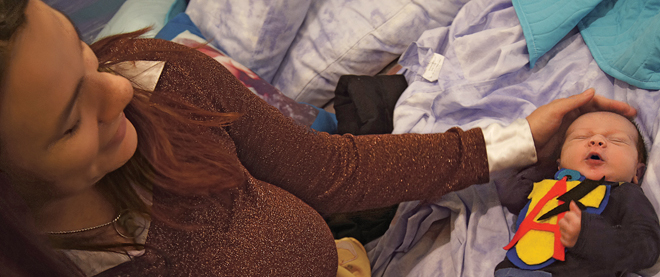Are exhibitionist births dangerous?
One of the fathers of the natural childbirth movement says yes
Johannes Kroemer/Getty Images
Share

It may have been the year’s most anticipated birth—and it certainly was the most sensational. On Oct. 25, New York performance artist Marni Kotak delivered a baby boy in a Brooklyn gallery in front of an audience of 20. As worldwide press inundated the gallery for information, Kotak retreated from the spotlight. But a week later she and baby Ajax were back in the gallery talking to visitors and finishing the exhibit she called “The Birth of Baby X”—now complete with the placenta, the bloody pillow and sheets and, of course, the video. Canada had its own public childbirth in October, when Ottawa chiropractor Nancy Salgueiro live-streamed the home birth of her third child over the Internet and 2,500 people watched. Nothing, it seems, is sacred anymore, not even the once very private act of pushing out a baby. And now a retired French obstetrician says stunts like these have not only perverted the idea of natural childbirth, but are actually setting women up for dangerous births.
“We are at the present time—in regard to the history of childbirth—at the bottom of the abyss,” says Michel Odent, who’s been a part of over 15,000 hospital births and is widely considered to be one of the fathers of the natural childbirth movement, having introduced water births in the 1970s. And he blames it on all the people in the room—medical staff, partners, family members, doulas and especially cameras. “People look at [birth] videos and miss the important point—that during childbirth the most basic need of a labouring woman is not to feel observed.”
The 81-year-old doctor describes birth as an “involuntary process” that cannot be helped. So all the support people are making it more difficult for the labouring woman to do it on her own. Fetal monitors, cameras, people talking and other stimuli engage the thinking part of her brain, the neocortex, which needs to be shut off in order for the woman to produce the hormones needed to have a baby quickly and easily. Instead, the majority of women experience long, painful labours and are fed synthetic forms of the “love hormone” oxytocin.
“It is not a surprise that modern births are more and more difficult,” says Odent, citing the rising rates of Caesarean section (nearly 30 per cent in Canada) and new statistics showing that more home births are being transferred to hospitals. “We have a lack of understanding about the birth process.”
So what is Odent’s ideal situation for an easy birth? “Nobody present but the delivering woman and an experienced and silent midwife sitting in a corner perceived as a protector, a mother figure.” And he adds that the midwife should be knitting. “We know today that repetitive tasks like knitting are a way to reduce the level of adrenalin. And it is very important that the level of the adrenalin in the midwife is as low as possible.”
Toronto midwife doula and childbirth educator Karen McWilliams says she gets it—we’re like all other mammals who need darkness, quiet and safety to give birth. “But the reality is we don’t live in that world. For good or bad, all those images of birth are out there, women have heard stories, seen videos. And most are scared and don’t want to do it alone.”
In Ottawa, Salgueiro wanted to show that a calm, natural birth is nothing to fear, “where you’re empowered and you don’t feel like it’s out of your control,” she said, three days after her son Oziah was born. Based on the reactions from people who watched it—including expecting couples, families who showed their young children and older men who weren’t given the opportunity of seeing their own children born—Salgueiro’s video was educational and appreciated.
Odent acknowledges that people like Salgueiro are filled with good intentions. “They want to further natural childbirth, but are doing the exact opposite. From these videos people think what makes a birth natural is the position of the woman giving birth or the fact that she’s at home or that she’s in a birthing pool. But what makes a birth natural is to feel secure without feeling observed.”
What’s even more dangerous, he says, is that videos of hospital births with multiple people running in and out of the room, and videos of home births in which the whole family, doulas and midwives are involved, further the basic “cultural conditioning that a woman does not have the power to give birth by herself, that she needs other people.”
Odent is ready to take his message to the world and says, at his age, he is no longer worried about being diplomatic when discussing who should be, and who should not be, in the room. He’s co-organizing a 2012 conference in Hawaii, which he’s dubbed “the Big Wake-Up Call.” The program includes discussions of a new, less-intrusive C-section technique, the behavioural effects of synthetic oxytocin, and utopian thoughts on childbirth in 4012. It wraps up with “Silent knitting: rediscovering authentic midwifery.” No talking—and absolutely no cameras.